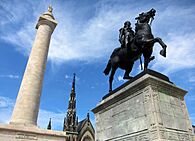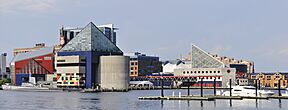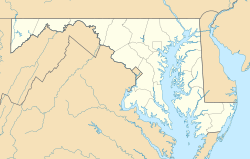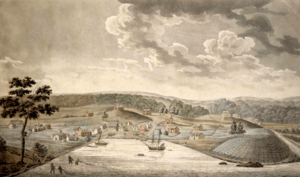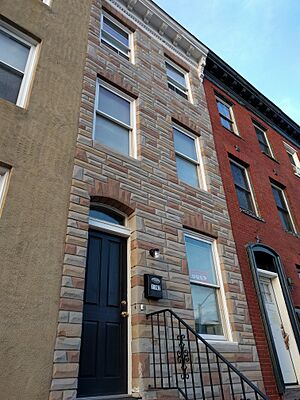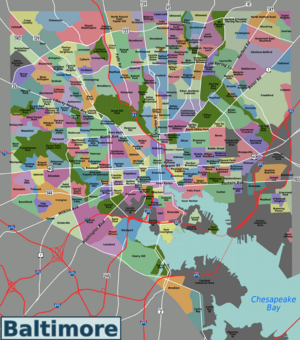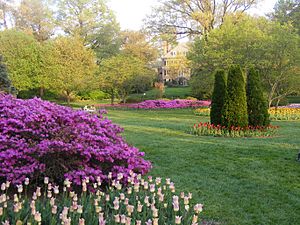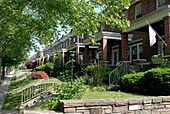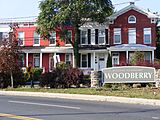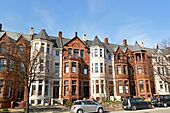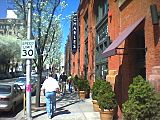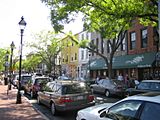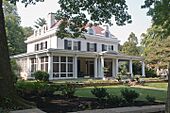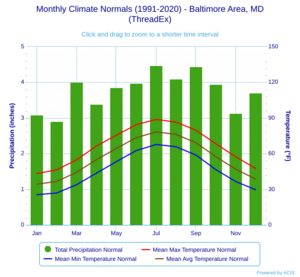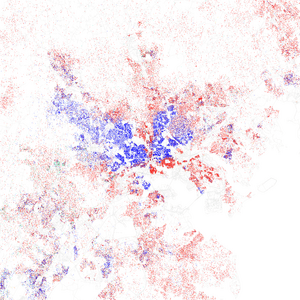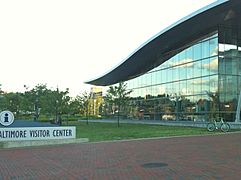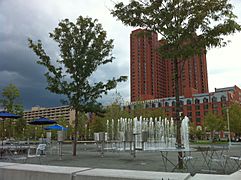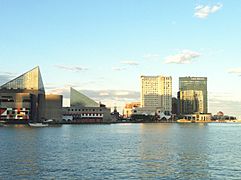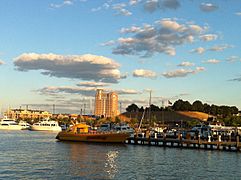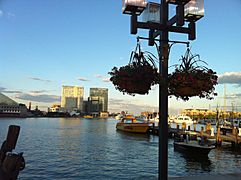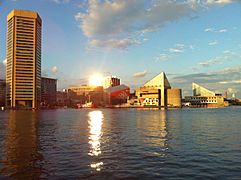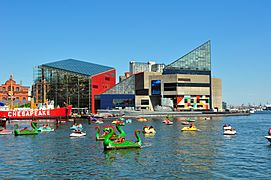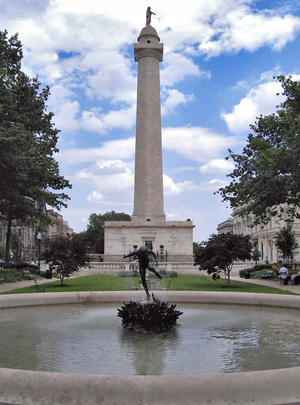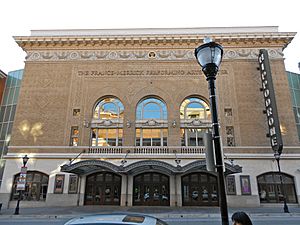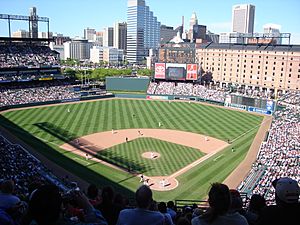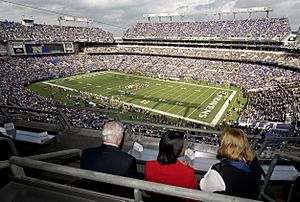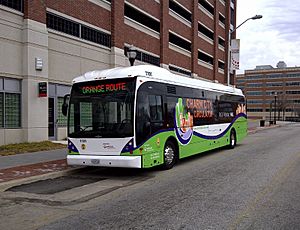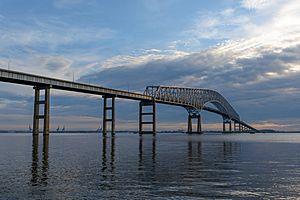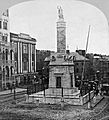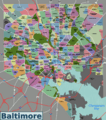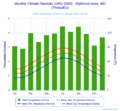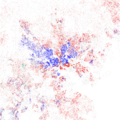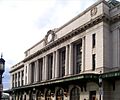Baltimore facts for kids
Quick facts for kids
Baltimore
|
|||
|---|---|---|---|
|
The Inner Harbor skyline
Washington and Lafayette Monuments
|
|||
|
|||
| Nicknames:
Charm City; B'more; Mobtown
|
|||
| Motto(s):
"The Greatest City in America", "Get in on it.", "Believe"
|
|||
| Country | United States | ||
| State | Maryland | ||
| City | Baltimore | ||
| Historic colony | Province of Maryland | ||
| County | None (Independent city) | ||
| Founded | August 8, 1729 | ||
| Incorporated | 1796–1797 | ||
| Independent city | 1851 | ||
| Named for | Cecil Calvert, 2nd Baron Baltimore | ||
| Government | |||
| • Type | Mayor–council | ||
| • Body | Baltimore City Council | ||
| Area | |||
| • Independent city | 92.05 sq mi (238.41 km2) | ||
| • Land | 80.95 sq mi (209.65 km2) | ||
| • Water | 11.10 sq mi (28.76 km2) 12.1% | ||
| Elevation | 0–480 ft (0–150 m) | ||
| Population
(2020)
|
|||
| • Independent city | 585,708 | ||
| • Estimate
(2021)
|
576,498 | ||
| • Rank | 83rd in North America 30th in the United States 1st in Maryland |
||
| • Density | 7,235.43/sq mi (2,793.74/km2) | ||
| • Urban | 2,212,038 (US: 20th) | ||
| • Urban density | 3,377.5/sq mi (1,304.1/km2) | ||
| • Metro | 2,844,510 (US: 20th) | ||
| Demonym(s) | Baltimorean | ||
| GDP | |||
| • Independent city | $59.380 billion (2022) | ||
| • Metro | $241.399 billion (2022) | ||
| Time zone | UTC−5 (EST) | ||
| • Summer (DST) | UTC−4 (EDT) | ||
| ZIP Codes |
ZIP Codes
|
||
| Area codes | 410, 443, and 667 | ||
| Congressional districts | 2nd, 7th | ||
| GNIS feature ID | 597040 | ||
Baltimore is the largest city in Maryland, a state in the United States. In 2020, about 585,708 people lived there. This makes it the 30th most populated city in the U.S. Baltimore became an independent city in 1851. This means it is not part of any county.
Long ago, Paleo-Indians used the Baltimore area for hunting. Later, the Susquehannock tribe hunted there in the early 1600s. The Province of Maryland started the Port of Baltimore in 1706. This port helped trade tobacco with Europe. The town of Baltimore was officially founded in 1729.
During the American Revolutionary War, Baltimore was briefly the nation's capital. This happened from December 1776 to February 1777. The city played a big role in the War of 1812. The British tried to bomb Fort McHenry, but they failed. This event inspired Francis Scott Key to write "The Star-Spangled Banner". This poem later became the U.S. national anthem.
The Baltimore and Ohio Railroad, built in 1830, made Baltimore an important transportation center. It helped connect the city's port to the Midwest. Baltimore's Inner Harbor was once a major entry point for immigrants. It was also a big center for making things. Today, Baltimore's economy focuses more on services. Johns Hopkins Hospital and University are major employers. The city is home to the Baltimore Orioles baseball team and the Baltimore Ravens football team.
Many neighborhoods in Baltimore have rich histories. Some of the oldest historic districts in the U.S. are here. These include Fell's Point, Federal Hill, and Mount Vernon. Baltimore has more public statues and monuments per person than any other U.S. city. Over 65,000 buildings are listed as historic.
Baltimore's History
Early Times
Native Americans lived in the Baltimore area for a very long time. They were here as early as 10,000 BC. Many ancient sites have been found in Baltimore. In 2021, tools and other items from 5,000 to 9,000 years ago were found in Herring Run Park.
City's Name
Baltimore is named after Cecil Calvert, 2nd Baron Baltimore. He was an English nobleman and the founder of the Province of Maryland. The name "Baltimore" comes from an Irish name, Baile an Tí Mhóir. This means "town of the big house."
1600s: First Settlements
In the early 1600s, few Native Americans lived right in the Baltimore area. The Susquehannock tribe used the land north of Baltimore for hunting. They were an Iroquoian-speaking people. The Piscataway tribe, who spoke Algonquian, lived further south.
Europeans began settling in Maryland in 1634. They arrived on a ship called The Ark. Streets in colonial Baltimore were named to show loyalty to England. For example, there were King, Queen, and Caroline streets. In 1661, David Jones claimed land that is now Jonestown.
1700s: Growing Up
The Maryland General Assembly created the Port of Baltimore in 1706. It was for trading tobacco. Baltimore Town was founded on August 8, 1729. By 1752, it had only 27 homes. Nearby settlements like Jonestown and Fells Point joined it. In 1768, these areas became a commercial center.
The first printing press came to Baltimore in 1765. It was used to print the city's first newspapers. Baltimore grew quickly in the 1700s. Plantations produced grain and tobacco. These goods were sent to Caribbean colonies.
Baltimore started its public market system in 1763. Lexington Market, founded in 1782, is one of the oldest markets in the U.S. Historically, some markets in Baltimore, like Lexington Market, were unfortunately involved in the slave trade.
In 1774, Baltimore created the first post office system in the U.S. It also had the first water company in the new nation in 1792. Baltimore played a role in the American Revolution. City leaders resisted British taxes. The Second Continental Congress met in Baltimore from December 1776 to February 1777. This made Baltimore the U.S. capital for a short time. Baltimore, Jonestown, and Fells Point officially became the City of Baltimore in 1796–1797.
1800s: Monuments and Growth
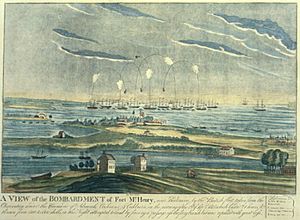
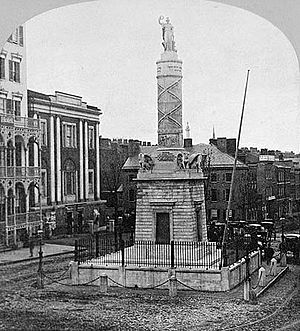
Baltimore became an independent city in 1851. The Battle of Baltimore in 1814 inspired the U.S. national anthem. It also led to the building of the Battle Monument. This monument became the city's official symbol. President John Quincy Adams called Baltimore "The Monumental City" in 1827.
Baltimore was a leader in using gas lighting in 1816. The city's population grew fast. The National Road and the Baltimore and Ohio Railroad made Baltimore a major shipping and manufacturing center. By 1820, 60,000 people lived here. The economy changed from tobacco to sawmilling, shipbuilding, and textile production.
In 1835, Baltimore had one of the worst riots in the South. This was due to bad investments. The city was nicknamed "Mobtown" because of these events. The world's first dental college, the Baltimore College of Dental Surgery, opened in 1840. In 1844, the world's first telegraph line connected Baltimore and Washington, D.C..
Maryland stayed with the Union during the American Civil War. In 1861, Union soldiers clashed with a group of people in the Pratt Street riot. This was one of the first violent events of the war. In 1877, railroad workers went on strike due to wage cuts. This led to clashes with the National Guard.
1900s: Challenges and Revival
On February 7, 1904, the Great Baltimore Fire destroyed over 1,500 buildings. It burned for 30 hours. The city rebuilt and improved firefighting standards. In 1910, Baltimore passed a law to separate neighborhoods by race. This was the first such law in the U.S. Other cities followed, but the Supreme Court later ruled against these laws.
Baltimore grew by adding new suburbs until 1918. After 1948, a new law made it harder for the city to expand its borders. The city's Black population grew from 23.8% in 1950 to 46.4% in 1970. This was due to migration and white families moving to suburbs.
Following the assassination of Martin Luther King Jr. in 1968, Baltimore experienced unrest. Public order was restored after several days. In 1974, the city faced strikes by teachers, city workers, and police officers.
By the 1970s, Baltimore's Inner Harbor area was run down. It had many empty warehouses. The nickname "Charm City" was created in 1975 to improve the city's image. Efforts to rebuild the area began with the Maryland Science Center (1976) and the Baltimore World Trade Center (1977). Harborplace, a shopping and restaurant complex, opened in 1980. The National Aquarium opened in 1981.
In 1992, the Baltimore Orioles baseball team moved to Oriole Park at Camden Yards. Pope John Paul II held a large mass there in 1995. The Baltimore Ravens football team moved into M&T Bank Stadium in 1998. Baltimore has faced challenges with crime for many years. In April 2015, the city experienced major protests and received international attention. This led to a state of emergency and a curfew.
2000s: Modern Baltimore
In the 21st century, Baltimore has seen new cultural sites open. These include the Hippodrome Theatre (2004) and the Reginald F. Lewis Museum of Maryland African American History & Culture (2005). In 2012, Johns Hopkins Hospital completed a large new medical complex.
In 2016, the city approved a big project to redevelop Port Covington. This project includes new offices, homes, and the headquarters for Under Armour. On March 26, 2024, the Francis Scott Key Bridge collapsed after being hit by a ship. This caused a major rescue effort. The bridge is being rebuilt.
Baltimore's Geography
Baltimore is in north-central Maryland. It is on the Patapsco River, which flows into the Chesapeake Bay. The city is located where two land areas meet: the Piedmont Plateau and the Atlantic coastal plain. This divides Baltimore into "lower city" and "upper city." The city's height ranges from sea level to about 480 feet.
Baltimore covers about 92.1 square miles. About 80.9 square miles are land, and 11.1 square miles are water. The city is surrounded by Baltimore County but is politically separate. Anne Arundel County is to the south.
City's Look
Buildings and Design
Baltimore has many important buildings from different time periods. Famous architects like Benjamin Henry Latrobe and I. M. Pei designed buildings here. The Baltimore Basilica (1806–1821) is one of the oldest Catholic cathedrals in the U.S. The Peale Museum was the first building in the U.S. designed specifically as a museum.
The Phoenix Shot Tower (1828) was the tallest building in the U.S. until the Civil War. It is 234 feet tall. The Baltimore World Trade Center (1977) is the tallest five-sided building in the world.
Baltimore's streets are laid out in a grid. They are lined with thousands of rowhouses. These rowhouses often have brick or "formstone" fronts. Formstone is a special type of fake stone. Rowhouses became the main type of house in Baltimore in the 1800s.
Oriole Park at Camden Yards is a baseball park that opened in 1992. It looks like an old-fashioned ballpark. Along with the National Aquarium, Camden Yards helped bring life back to the Inner Harbor.
Tallest Buildings
| Rank | Building | Height | Floors | Built | |
|---|---|---|---|---|---|
| 1 | Transamerica Tower | 529 feet (161 m) | 40 | 1973 | |
| 2 | Bank of America Building | 509 feet (155 m) | 37 | 1929 | |
| 3 | 414 Light Street | 500 feet (152 m) | 44 | 2018 | |
| 4 | William Donald Schaefer Tower | 493 feet (150 m) | 37 | 1992 | |
| 5 | Commerce Place | 454 feet (138 m) | 31 | 1992 | |
| 6 | Baltimore Marriott Waterfront Hotel | 430 feet (131 m) | 32 | 2001 | |
| 7 | 100 East Pratt Street | 418 feet (127 m) | 28 | 1975/1992 | |
| 8 | Baltimore World Trade Center | 405 feet (123 m) | 28 | 1977 | |
| 9 | Tremont Plaza Hotel | 395 feet (120 m) | 37 | 1967 | |
| 10 | Charles Towers South | 385 feet (117 m) | 30 | 1969 |
Neighborhoods
Baltimore is divided into nine main areas: North, Northeast, East, Southeast, South, Southwest, West, Northwest, and Central. Each area has its own police district.
Central Baltimore
Central Baltimore is the city's main business area. It includes sports stadiums like Oriole Park at Camden Yards and M&T Bank Stadium. The Inner Harbor has attractions like Harborplace and the National Aquarium. The University of Maryland, Baltimore and Lexington Market are also here. This area also has many cultural places like the Maryland Institute College of Art and the Walters Art Museum.
North Baltimore
North Baltimore has many historic neighborhoods. These include Roland Park, Guilford, and Hampden. Morgan State University is in this area. The Station North Arts and Entertainment District is also here.
South Baltimore
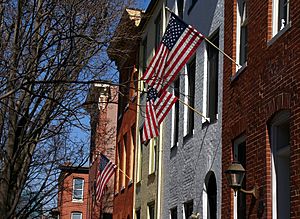
South Baltimore is a mix of industrial and residential areas. It is a diverse waterfront area. Neighborhoods like Locust Point and Federal Hill are here. Historic Fort McHenry is at the end of the peninsula.
Northeast Baltimore
Northeast Baltimore is mostly residential. It is home to Morgan State University. Baltimore City College high school, one of the oldest public high schools in the U.S., is also here. Lake Montebello is a popular spot in Northeast Baltimore.
East Baltimore
East Baltimore is mainly residential. It is home to Johns Hopkins Hospital and the Johns Hopkins University School of Medicine. Famous TV shows like The Wire were filmed in this area.
Southeast Baltimore
Southeast Baltimore is a mix of industrial and residential areas along the waterfront. Patterson Park is a large park here. Historic neighborhoods include Fells Point, Highlandtown, and Little Italy.
Northwest Baltimore
Northwest Baltimore is mostly residential. It is home to Pimlico Race Course and Sinai Hospital. This area has been a center for Baltimore's Jewish community.
West Baltimore
West Baltimore is west of downtown. It includes historic neighborhoods like Harlem Park and Sandtown-Winchester. This area was once a center for the city's Black community. Coppin State University and Mondawmin Mall are here.
Southwest Baltimore
Southwest Baltimore includes neighborhoods like Pigtown and Carrollton Ridge. St. Agnes Hospital is in this district. The historic National Road began in this part of Baltimore.
Climate
Baltimore has a humid subtropical climate. This means it has hot summers and cool winters. July is the warmest month, with an average temperature of about 80°F (27°C). Winters can be chilly, with January averaging about 36°F (2°C). Snowfall varies greatly each year.
Spring and autumn are mild. Summers are hot and humid, with thunderstorms. The city can experience flooding from hurricanes or their remnants. Baltimore is at risk from climate change, which can increase flooding.
The highest temperature ever recorded was 108°F (42°C) in July 2011. The lowest was -7°F (-22°C) on several occasions.
People of Baltimore
Population Changes
| Historical population | ||
|---|---|---|
| Year | Pop. | ±% |
| 1752 | 200 | — |
| 1775 | 5,934 | +2867.0% |
| 1790 | 13,503 | +127.6% |
| 1800 | 26,514 | +96.4% |
| 1810 | 46,555 | +75.6% |
| 1820 | 62,738 | +34.8% |
| 1830 | 80,620 | +28.5% |
| 1840 | 102,313 | +26.9% |
| 1850 | 169,054 | +65.2% |
| 1860 | 212,418 | +25.7% |
| 1870 | 267,354 | +25.9% |
| 1880 | 332,313 | +24.3% |
| 1890 | 434,439 | +30.7% |
| 1900 | 508,957 | +17.2% |
| 1910 | 558,485 | +9.7% |
| 1920 | 733,826 | +31.4% |
| 1930 | 804,874 | +9.7% |
| 1940 | 859,100 | +6.7% |
| 1950 | 949,708 | +10.5% |
| 1960 | 939,024 | −1.1% |
| 1970 | 905,787 | −3.5% |
| 1980 | 786,741 | −13.1% |
| 1990 | 736,016 | −6.4% |
| 2000 | 651,154 | −11.5% |
| 2010 | 620,961 | −4.6% |
| 2020 | 585,708 | −5.7% |
| U.S. Decennial Census 1790–1960 1900–1990 1990–2000 2010–2020 1752 estimate & 1775 census |
||
Baltimore's population was highest in 1950, with almost 950,000 people. Since then, the population has slowly decreased. In 2020, it was 585,708. Baltimore is known as a sanctuary city, which means it has policies to protect immigrants.
Some neighborhoods are seeing gentrification. This means that wealthier people are moving in and improving areas. This can change the mix of people living there.
Baltimore was the second U.S. city to reach 100,000 people. It was one of the top 10 most populated cities until the 1980 census.
Who Lives in Baltimore?
In 2010, Baltimore's population was mostly Black (63.7%) and White (29.6%). About 4.2% of people were of Hispanic, Latino, or Spanish origin. The city also has a large Caribbean American population, especially Jamaicans and Trinidadians.
In 2020, about 8.1% of residents were born in other countries. Females made up 53.4% of the population. The average age was 35 years old.
Money and Homes
Between 2016 and 2020, the average household income in Baltimore was $52,164. This is lower than the national average. In 2020, 20% of Baltimore residents lived in poverty.
Homes in Baltimore are generally less expensive than in other large coastal cities. The average home price in December 2022 was $209,000. The number of people experiencing homelessness in Baltimore has been increasing.
Health and Life Expectancy
In 2015, the average life expectancy in Baltimore was 74 to 75 years. This is a bit lower than the U.S. average. Some neighborhoods had lower life expectancies.
Religion and Languages
In 2015, about 50% of adults in Baltimore were Protestants. Catholicism was the second-largest religion (15%). Other religions include Judaism (3%) and Islam (2%).
In 2010, most Baltimore residents (91%) spoke only English at home. About 4% spoke Spanish. Other languages like African languages, French, and Chinese were spoken by smaller groups.
Baltimore's Economy
Baltimore used to be a big industrial city. It focused on steel, shipping, and making cars. But then, many factories closed. This caused the city to lose many jobs. Now, Baltimore's economy relies more on services.
In March 2018, the unemployment rate was 5.8%. In 2012, one-quarter of Baltimore residents lived in poverty. The Johns Hopkins Hospital is a major employer. Other big companies include Under Armour and T. Rowe Price. The city's tech industry is growing fast.
The Port
The Port of Baltimore is a very important part of the city's economy. It is ranked among the top U.S. ports for the value of goods it handles. In 2014, goods worth $52.5 billion moved through the port. The port supports many jobs and brings in a lot of tax money.
The port handles many types of cargo. It is number one in the U.S. for handling cars and light trucks. It also handles farm and construction machinery. The port's cruise industry brings in over $90 million each year. The port is expanding to handle even larger ships.
Tourism
Baltimore is a popular place for tourists. In 2014, 24.5 million visitors came to the city. They spent $5.2 billion. Much of the tourism is around the Inner Harbor. The National Aquarium is Maryland's most popular tourist spot.
The Inner Harbor has many historic ships. These include the USS Constellation, a Civil War-era ship. There's also the USS Torsk, a submarine. The WHEC-37 is a Coast Guard ship that was at Pearl Harbor in 1941. These ships are part of the Historic Ships in Baltimore organization.
Other popular places to visit include sports stadiums, Fort McHenry, and historic neighborhoods like Fells Point. Museums like the Walters Art Museum and the Maryland Science Center are also popular.
-
The Baltimore Visitor Center at the Inner Harbor
-
Baltimore is the home of the National Aquarium, one of the world's largest aquariums.
Baltimore's Culture
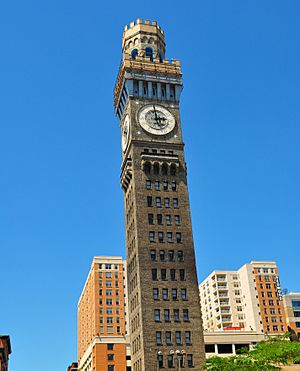
Baltimore is known as a "city of neighborhoods." It has 72 historic districts. The Inner Harbor is popular with tourists. Fells Point and Little Italy are also well-known areas. Mount Vernon is the city's cultural center. It has a Washington Monument that is older than the one in Washington, D.C.
Baltimore has a large German American population. It was once the second-largest port for immigrants in the U.S. Many people from Germany, Poland, Ireland, and Italy came here.
Beer making was big in Baltimore from the 1800s to the 1950s. The National Brewing Company made the first six-pack of beer. Its brands, National Bohemian ("Natty Boh") and Colt 45, are still popular.
The Artscape is a large free arts festival held each year. The Maryland Film Festival also takes place in Baltimore. Many movies and TV shows have been filmed here, like Homicide: Life on the Street and The Wire.
Baltimore has many museums. The Baltimore Museum of Art and the Walters Art Museum have famous art collections. The American Visionary Art Museum is the national museum for visionary art. The National Great Blacks In Wax Museum is the first African American wax museum in the country.
Food in Baltimore
Baltimore is famous for its blue crabs, crab cakes, and Old Bay Seasoning. The city has many restaurants, especially around the Inner Harbor. Lexington Market is one of the oldest continuously operating markets in the world. Baltimore is also the last place in America where you can still find arabbers. These vendors sell fruits and vegetables from horse-drawn carts.
Local Way of Speaking
Baltimore has a unique way of speaking called the Baltimore dialect. It's sometimes called "Bawlmerese." It's known for how people say the long "o" sound. Filmmaker John Waters, who is from Baltimore, often uses the city and its dialect in his movies.
Performing Arts
Baltimore has several arts and entertainment districts. The Baltimore Office of Promotion and The Arts organizes big events. These include New Year's Eve fireworks and Artscape.
The Baltimore Symphony Orchestra is a famous orchestra. Centerstage is a leading theater company. The Lyric Opera House hosts the Lyric Opera Baltimore. Many historic theaters in Baltimore have been restored.
The Peabody Institute is the oldest music conservatory in the U.S. It is a very respected music school. The Baltimore School for the Arts is a public high school known for its arts programs.
Sports in Baltimore
Baseball
Baltimore has a rich baseball history. Babe Ruth was born here in 1895. The original Baltimore Orioles team was very successful in the late 1800s. The team that became the New York Yankees started in Baltimore.
The current Baltimore Orioles team has been in Major League Baseball since 1954. They have won the World Series three times (1966, 1970, and 1983). Cal Ripken Jr., a local player, broke a record for playing the most consecutive games. The Orioles' home is Oriole Park at Camden Yards, which opened in 1992.
Football
Baltimore has had several professional football teams. The Baltimore Colts were a successful NFL team in the 1950s and 60s. They won the NFL Championship twice and the Super Bowl once. In 1984, the Colts moved to Indianapolis.
The NFL returned to Baltimore in 1996 with the Baltimore Ravens. The Ravens have won two Super Bowl championships (2000 and 2012). They play at M&T Bank Stadium.
Other Sports
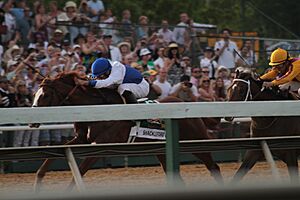
The Preakness Stakes, a famous horse race, is held every May at Pimlico Race Course. College lacrosse is also very popular. The Johns Hopkins Blue Jays men's lacrosse team has won many national championships.
The Baltimore Blast is a professional indoor soccer team. They have won many championships. Under Armour, a sports equipment company, is based in Baltimore. The Baltimore Marathon is a popular running race that goes through many city neighborhoods.
Parks and Fun
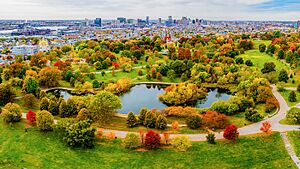
Baltimore has over 4,900 acres of parkland. The Department of Recreation and Parks manages most parks. These include Patterson Park, Federal Hill Park, and Druid Hill Park. Fort McHenry National Monument and Historic Shrine is a famous fort from the War of 1812.
Learning in Baltimore
Colleges and Universities
Baltimore has many colleges and universities. About 100,000 students attend these schools.
Private Schools
- Johns Hopkins University
- Loyola University Maryland
- Maryland Institute College of Art
- St. Mary's Seminary and University
- Notre Dame of Maryland University
- The Peabody Institute of Johns Hopkins University
Public Schools
- Baltimore City Community College
- Coppin State University
- Morgan State University
- University of Baltimore
- University of Maryland, Baltimore
High Schools
Baltimore City Public Schools manage the city's public schools. Some notable high schools include:
- Carver Vocational-Technical High School, the first African American vocational high school in Maryland.
- Digital Harbor High School, which focuses on information technology.
- Frederick Douglass High School, one of the oldest African American high schools in the U.S.
- Baltimore City College, the third-oldest public high school in the nation.
- Western High School, the oldest public all-girls school in the nation.
Getting Around Baltimore
Baltimore has a higher number of households without a car compared to the national average.
Roads and Highways
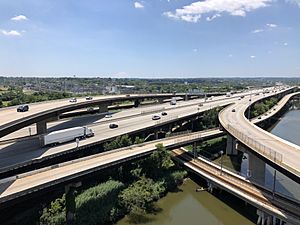
Major highways serving Baltimore include I-70, I-83, and I-95. Some planned highways were not built due to protests from residents.
There are two tunnels under Baltimore Harbor: the Fort McHenry Tunnel (I-95) and the Harbor Tunnel (I-895). The Francis Scott Key Bridge used to cross the harbor but collapsed in 2024.
Public Transportation
The Maryland Transit Administration (MTA Maryland) provides public transportation. This includes a large bus network, a light rail line, and a subway line.
The Charm City Circulator is a free shuttle bus service. It runs on four routes through downtown Baltimore. Baltimore also has a water taxi service in the Inner Harbor.
Trains
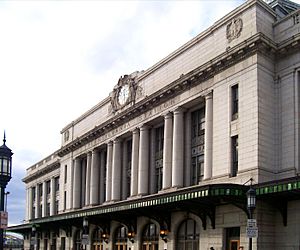
Baltimore is a major stop for Amtrak trains. Penn Station is one of the busiest train stations in the U.S. The MARC commuter rail connects Baltimore with Washington, D.C.
Airports
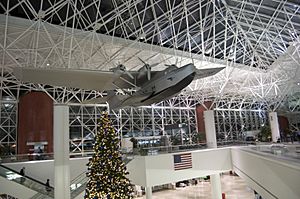
Baltimore has two airports. Baltimore–Washington International Thurgood Marshall Airport (BWI) is about 10 miles south of the city. It is named after Thurgood Marshall, a Baltimore native and Supreme Court Justice. BWI is one of the busiest airports in the U.S. Martin State Airport is a smaller airport for general aviation.
Walking and Biking
Baltimore has many bicycle routes. These routes are marked with green signs. The city also has three main trail systems: the Gwynns Falls Trail, the Jones Falls Trail, and the Herring Run Trail. These trails are great for biking and walking.
Port of Baltimore
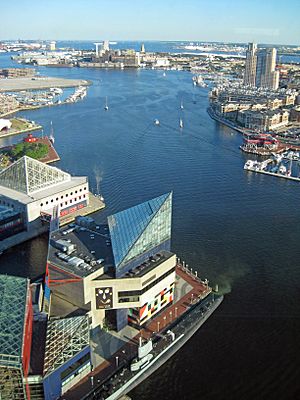
The Port of Baltimore was founded in 1706. It was important for the tobacco trade. Fells Point became a center for shipbuilding. The port was also a major stop for immigrants. Today, the port handles many goods, including cars and steel. It also has a passenger cruise terminal.
Environment
Baltimore's Inner Harbor, though beautiful, has faced pollution issues. The Waterfront Partnership of Baltimore is working to clean the waterways. They hope the harbor will be clean enough for swimming and fishing again.
Trash Clean-up
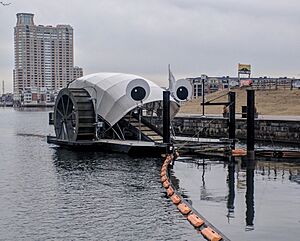
Baltimore uses special "water wheel" machines to remove trash from its waterways. "Mr. Trash Wheel" is at the mouth of the Jones Falls River. "Professor Trash Wheel," "Captain Trash Wheel," and "Gwynnda, the Good Wheel of the West" are other similar machines. The trash collected is used to generate electricity.
Water Quality Projects
Other projects to improve water quality include "Blue Alleys" and stream restoration. The National Aquarium also launched a floating wetland island in the Inner Harbor. These wetlands help clean the water and provide homes for animals.
Air Quality
The Wheelabrator Baltimore incinerator burns waste to create energy. This incinerator is a source of air pollution. Environmental groups are working to ensure pollution is monitored.
Media
The Baltimore Sun is Baltimore's main newspaper. It covers local, regional, and national news. The Baltimore Afro-American is an important African American newspaper.
Baltimore is a major media market for television and radio. All major English language TV networks have stations here. WJZ-TV is a CBS station, and WBFF is a Fox station.
Famous People from Baltimore
- Spiro Agnew, former U.S. Vice President
- Eubie Blake, jazz pianist and composer
- Muggsy Bogues, former professional basketball player
- Julie Bowen, actress
- Tom Clancy, author
- Elijah Cummings, former U.S. Congressman
- Cass Elliot, singer from The Mamas & the Papas
- David Hasselhoff, actor
- Billie Holiday, jazz singer
- Johns Hopkins, philanthropist and namesake of Johns Hopkins University
- Francis Scott Key, wrote "The Star-Spangled Banner"
- Thurgood Marshall, U.S. Supreme Court Justice
- H. L. Mencken, journalist and writer
- Nancy Pelosi, former Speaker of the U.S. House of Representatives
- Michael Phelps, Olympic swimmer with many medals
- Edgar Allan Poe, poet
- Babe Ruth, famous baseball player
- Tupac Shakur, musician and actor
- Jada Pinkett Smith, actress
- John Waters, filmmaker
- Frank Zappa, rock musician
Sister Cities
Baltimore has eleven sister cities around the world. These partnerships help connect Baltimore with other cultures.
| City | Country | Year designated |
|---|---|---|
| Alexandria | Egypt | 1995 |
| Ashkelon | Israel | 1974 |
| Bendigo | Australia | 2023 |
| Changwon | South Korea | 2018 |
| Gbarnga | Liberia | 1973 |
| Kawasaki | Japan | 1979 |
| Luxor | Egypt | 1995 |
| Odesa | Ukraine | 1974 |
| Piraeus | Greece | 1982 |
| Rotterdam | Netherlands | 1985 |
| Xiamen | China | 1985 |
Three other cities have "emeritus status" as sister cities:
| City | Country | Year designated |
|---|---|---|
| Genoa | Italy | 1985 |
| Ely O'Carroll | Ireland | |
| Bremerhaven | Germany | 2007 |
Images for kids
See also
 In Spanish: Baltimore para niños
In Spanish: Baltimore para niños






